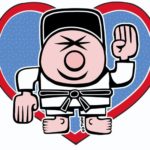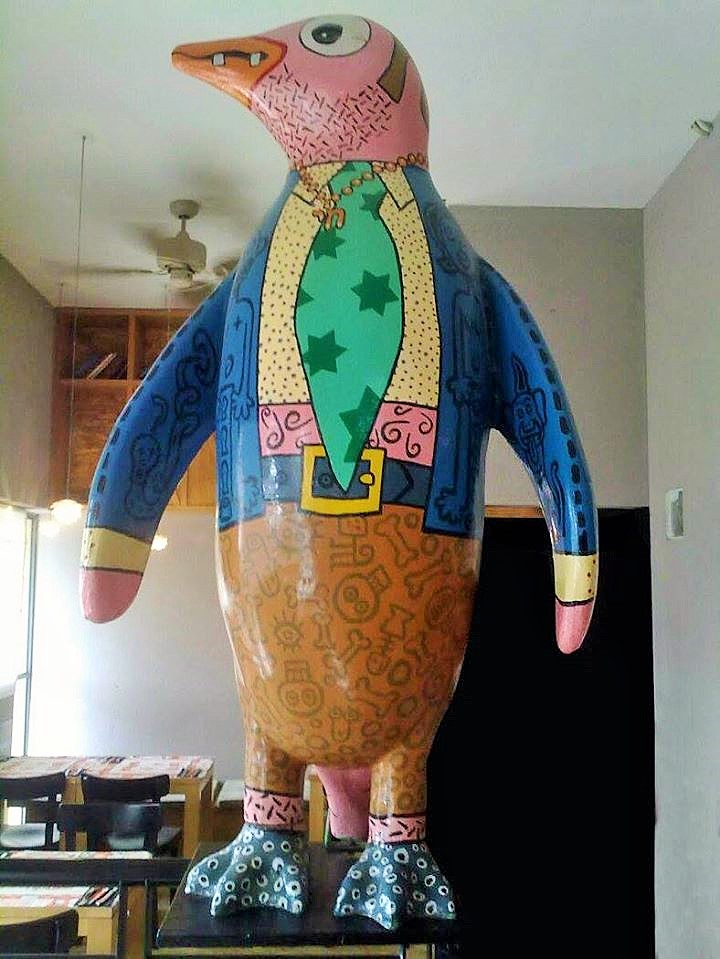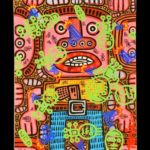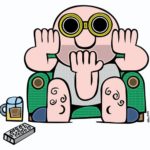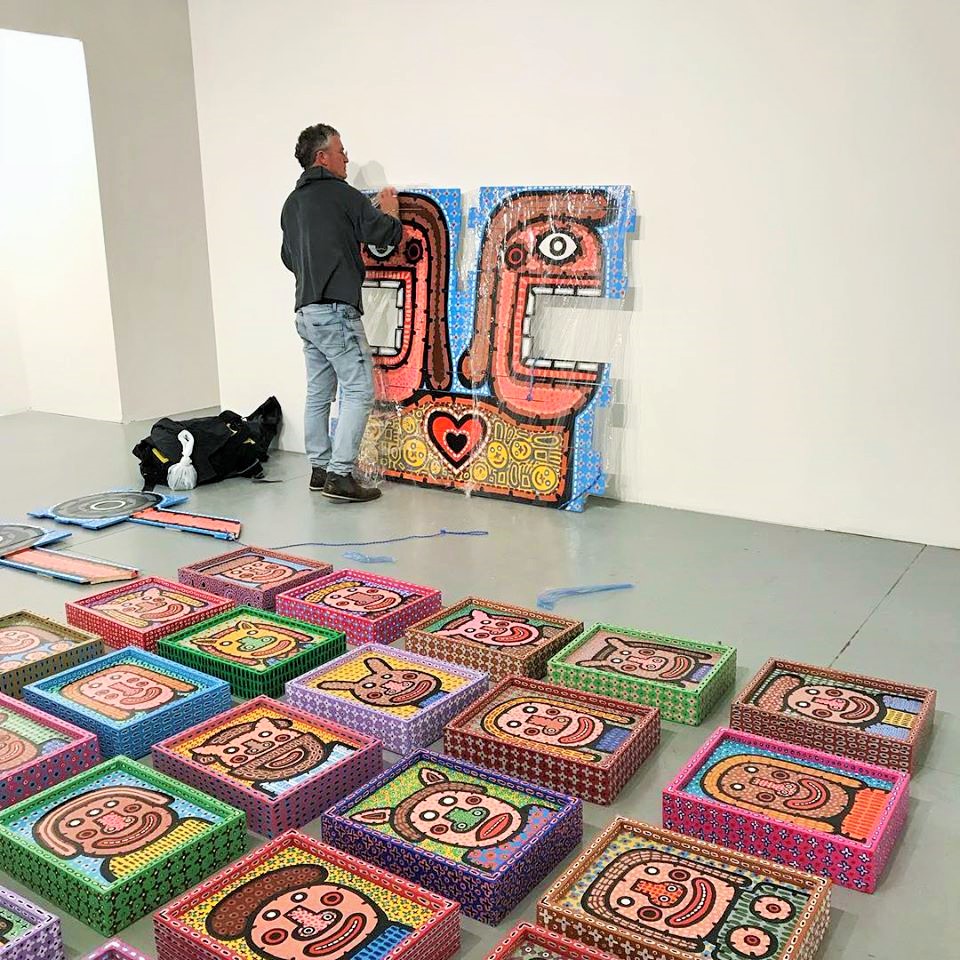At the beginning of the year, the artist Tamir Shefer from Tel Aviv visited Frankfurt for the fantastic exhibition „Echos“ at the Kunstverein Familie Montez. Works by him and nine other artists were shown, five of them from Israel, five from Germany. Tamir paints on canvases but also has a special preference for streetart and large-scale wall design in urban spaces. In the gallery rooms of the exhibition, he even painted some works directly and freshly on the interior façade. Of course we interviewed the creative artist!
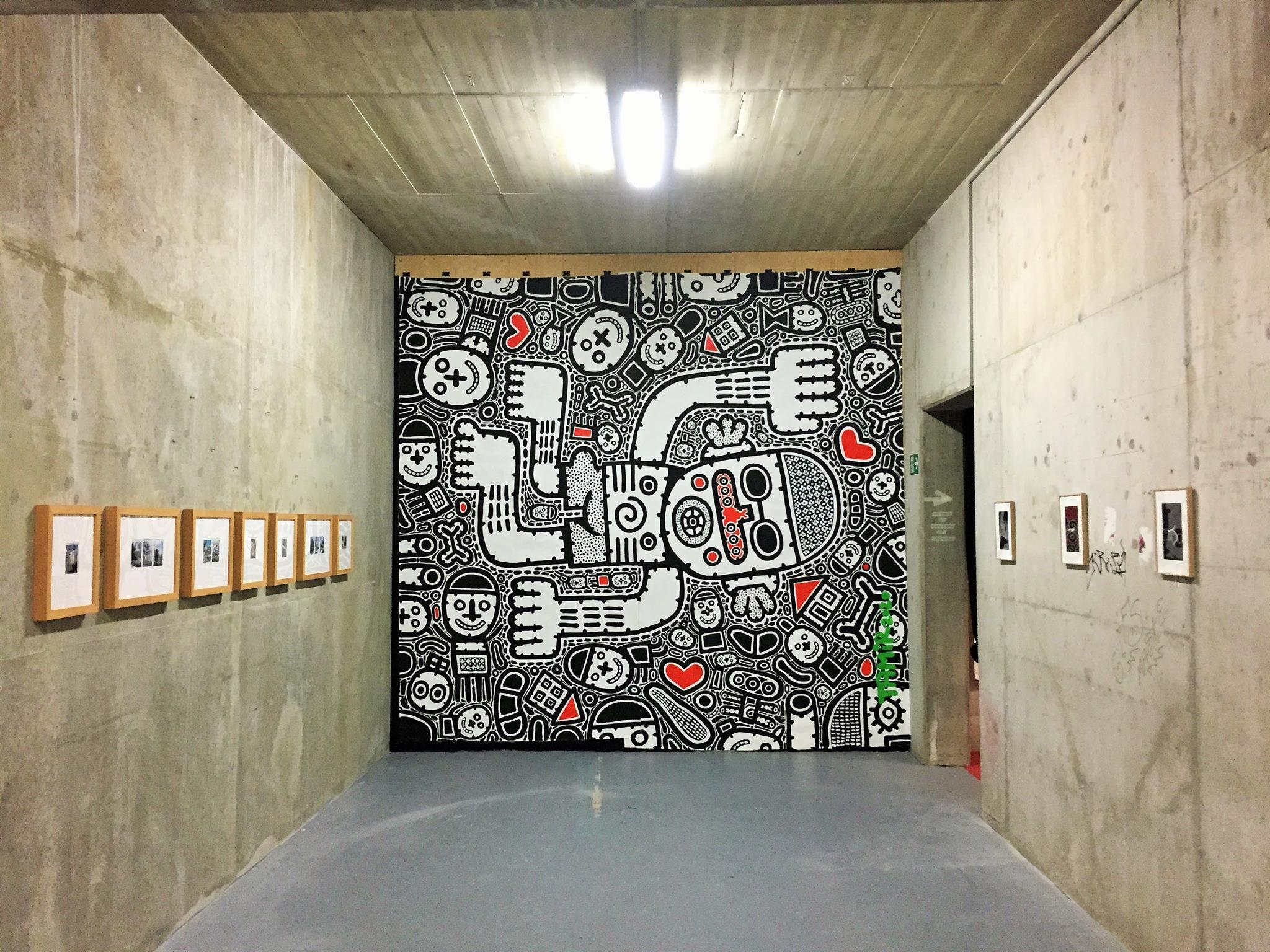
Tamir began his career as a comic creator and cartoonist for various newspapers in Israel, and later continued his work in San Francisco. He is a member of various alternative art groups and collectives, teaches as a professor at the Holon Institute of Technology in Tel Aviv and was the head of department of communication design at the institution for more than ten years. His artworks are strongly influenced by the comic world and the style of an ongoing story in pictures. Further influences shaped his art during countless journeys through Mexico while percepting the remains of the ancient Mayan culture.

His works of art are crammed with colorful figures, swarming masks and mythical icons often in a pop up style, comparable on the one hand to a cartoon strip, but also to the Mayan calendar, which flows endlessly like a spiral without beginning or end. Or like the circle of life. Tamir is a storyteller, but simply only presents a multitude of small scale objects and faces which form a bigger super structure and leaves the viewer free to choose an optical path through his creative labyrinth in the abstract and fascinating drawings.

The creations on the canvas are only a part of his doings, because Tamir sets no limits here as far as there is a surface to paint on. Theoretically he can paint on anything that has an underground. These can be motorcycles, cars, guitars, pianos, shoes, dinosaurs or countless house walls and murals in the urban space. Important for him is to take objects and places, around which life is flowing, which are visited and used by people and which themselves generate a social dynamic.

In a first interview, Tamir tells us about his art and his career from the cartoonist to a studio artist, awesome muralist and alternative professor. Unfortunately we did not have enough time at the exhibition and wanted to record the second part shortly afterwards via internet connection. But then Corona came and confused all planings. The second interview however now also took place with a slight delay. Here we focused more on the streetart scene in Tel Aviv. Both interviews can be heard here as podcasts and the conversations are also written down below peppered with great artworks and photos from Tamir Shefer.
You are an artist who paints on canvas but as well you love to do streetart.
Yes, I am an artist and as well a streetartist and a designer. I also work and teach in the academy and I kind of combine everything together in some way of mixture that creates art.

How did you start doing your art and how did it develop?
Actually my background is that I started as a cartoonist for newspapers. At a very early age I had a column in the Israeli papers and then later on I moved to San Francisco. There I lived for several years and worked for the Village Voice and the San Francisco Tribune as an illustrator and cartoonist. As well I was also part of the alternative comic scene in San Francisco. Also in Tel Aviv afterwards. Over the years when I got to San Francisco it was actually the beginning of the computer era. And since I came with the background of design and cartoons in a very natural way I got very active. I moved on very quickly since there was the whole revolution of technology. Computers started to get into San Francisco. It was that time.

Did you do digital painting then?
Sort of yes. Since my background is graphic and industrial design. And I came with many years of experience as an illustrator. So it was very natural to take some of the techniques because I understood 3d and I also my created lines fit very well to the computers because of its graphic nature. So my whole style was actually influenced by newspapers, comics and by computers. And while living in San Francisco I was very close to San Francisco. I spend quite a while travelling around Mexico and I was also very influenced by the area Oaxaca, the Maya and the whole meditation art as a way of release. And even they create art and burn it afterwards. A lot of streetart that I create is there but through the years it gets hit by rain and other graffiti sometimes. But I love the evolution of the art. I think compared to the different worlds I come from with computers and newspapers, I was looking for the life of the creation. And I think streetart creates a new form of life to a creation. Because all the time it is changing from the moment you create it. So I think this is the combination. And the other part is that as a cartoonist and being for several years a high-tech designer, I like the interaction with people and working on the street and create there is a whole new experience for an artist. You talk to people, you meet people and you actually create for people. So you are not alone in your studio, secluded from reality.

Or like in a fancy elite gallery, you are on the street at an open space where the life is.
Absolutely. I consider myself a pop artist and try to be popular. I talk in a language that hopefully people understand. I try at least. I build icons and the icons are usually very familiar to many people. And the connection between the icons is actually a story. I think each of us have very common ideas and common experiences but the in between is very individual. And I try in my art that can continue to life because each person sees the same but yet everybody sees the own personal story inside. So it becomes a whole new story with small differences but yet It creates a dynamic. The painting keeps on living because all the time is changing with each interpretation.

We watched some paintings before and you showed me some on your smartphone, it´s like a modern Mayan comic with icons. And for example with the Mayan calendar it doesn´t end, it´s like a circle. So you made a comic with no start and no ending. The murals are sometimes like that. And everybody can find something in the paintings and make their own story by going to the next part of the painting.
Very nice what you say. I will tell you as well a story from the years when I worked as a newspaper illustrator and cartoonist. Every artist wants his piece to live. To live a little bit longer. And I remember as a student one of my illustration teachers has told me: “Don´t forget that every illustration that you do. The next day they going to wrap a fish in it.” So this was always in the back of my head. You know you are always sitting and working but the life of your creation is very short. So at the beginning I started to create cartoons which were conceptual. They were actual comics and didn´t have a linear story to them. They were a collective of ideas and if you look at them you can put in your personal idea. And that actually created a story that could keep on living. But we are talking about prints and those had a certain lifeline to it. It starts and it ends. You keep it on your shelf or your drawer but it is not something you would keep on longer living.

And it keeps on staying on the comic level. Because it is what it is, just a short comic.
Yes, it´s a comic and in a certain context. People would read it who are actually are looking for this context. I think the last ten or twenty years the whole evolution to the technology that on one hand was very digital actually transformed ourselves back to the streets. All life is in circles. And the possibility of creating something where people live inside of it was like a great opportunity for someone who was looking for life for his creation. Because you create something not alone, cold, just non-connected to people. But you create something more and streetart is an art form that keeps on living and has is own evolution with weather, people, touching, taking pictures. It is a story teller. The minute I started creating art in the street all the new stories were added to what I did. That was even what I intended to do. It got its own life. Art is beautiful when you know how to start it but you never know where it is going. And it has actually a surprise in it and it brings something to birth again. It connects people and it just brings the stuff you cannot really plan. It works only if you do it and you let it flow.

It´s nice how you described that it started to develop its own life, its own soul. Because it´s also about the passion, but as well there is some kind of magic in it.
Oh yeah. It´s mostly magic. The technical side is the easy side. The magic side is the side I think every artist is really looking for. Because it´s the unknown. It´s stuff you cannot plan. I tell you again a little story about that. I go every day to swim in the pool outside in salt water next to my house. And there is a whole gang of old people sitting there. They talk outside the pool and usually I don´t pay attention too much. But one day one guy said: “Hey Man, there is this new building next to us and we have this drive way to the parking lot that is really really boring. Maybe you could come and paint that drive way and the entrance of the parking lot?” That was the main parking lot of the flea market in Yafo in Tel Aviv. They said they would ask the neighbors if I can paint there and they would give me some paint. So I started painting around my house and I kind of marked my area. A lot of streetartists like to create a territory. It´s a part of the creation. So I said, yes, great, let´s do it! I started painting there and I was standing outside on this big wall with nice sunlight. And the people who actually agreed didn´t really know to what they were agreeing to. So in the beginning there just stopped every car which was going down and the people asked: “What are you doing here? Why are you painting here?”
Or “I call the police!”
Yes. And “Who gave you permission?”. But actually what happened then, it was quite a lot of fun. It started out with the entrance of the parking lot. Once I finished it a lot of the neighbors saw that it is really nice to enter the parking lot with all this color around them. And they said: “Hey, why don´t you do some more?” Now it´s a huge parking lot and the main parking lot for the flea market in Yafo. It´s very big and the only one you can park in. And it looks terrible. It looked like a really disgusting place. And they said: “We will all put in some budget, all the neighbors. Here is a big complex and we all pay you to do that”. So since I am total I said, when they pay me to do all the inside of the parking lot why not also making the signs of the parking lot.

Let´s make it complete!
Yes, complete and a full experience. So I started doing that and we had this fun project. The people really were having fun. And at some point when I finished the project I thought, ok, I will leave now everything, that´s it. But then I started to get these pictures on Instagram or on Facebook. It turned out that place started to become famous. Yafo is a very popular place to get married and you take usually pictures next to the sea or on the old wall. But now suddenly this spot became one of the hottest spots to take pictures.

It changed the whole surrounding!
Yes, completely! And slowly models started to come and taking pictures with their cloths there also. Once a friend called me and told me that there is a new commercial out on television. And it´s all happening on my wall. Also musicians came and started playing on this wall. So slowly there started a whole new story around a creation. I love doing things like that. I have also been active in San Francisco and in Tel Aviv also. I am also a professor at Holon Institute of Technology, the HIT. There I teach design and communication design. I used to be the head of the department for the last ten years. So I have many of those graffitis which have been seen by students of mine. Also I belong to a lot of alternative groups. One is the most famous alternative comic group in Israel. I will give you some cool stuff that will blow you away. I had a weekly column for fifteen years in one of the major papers. It was political-social and with another very cool freak. We write about life and we talk exactly about that. There I have really many stories about that.

END OF INTERVIEW ONE AND START OF INTERVIEW TWO
Actually we wanted to continue our interview shortly after the exhibition in Frankfurt but then there came Corona and everything went a chaotic. Tell me a bit about the lockdown situation in Tel Aviv and the consequences there for the art scene.
Well I think it is not much different like it was and is in the rest of the world. At least of what we heard. We were also here for about a month and a half in lockdown and the past two weeks they started to open stuff. Tomorrow actually they are opening the restaurants and swimming pools. So there is a good positive vibe that´s coming in. Beyond that summer is here, so the beaches are packed. And I think that people are pretty much fed up with the Corona. Since there have been luckily very little cases lately so it is pretty much going back to normal in a very wired way. Slowly things are opening but you get the feeling life might be coming back soon.

Exhibitions couldn´t take place, as well no cultural events and you just mentioned before that you actually should be in Düsseldorf in Germany at the moment for another project. But unfortunately it is still not possible.
Yes, very unfortunately. I was supposed to be due a two month residency in Düsseldorf for an art project there. I still hope that in the next few months I will get there and do it after all. Hopefully everything will calm down a bit and there will be flights, which is very basic and which we need for that. I think theater here and things like that got hurt really badly in the last few months in Israel. Especially in Tel Aviv where the center is. There haven´t been any theater or any shows. Of course all the museums and galleries were also closed down. There has been actually an interesting scene going on. A lot of artists and actors and all forms of art were locked down and they found new avenues of creativity. Not always with the same impact but a lot through the internet and through zoom. I saw some funky stuff happening which was really nice to see. Although it is all under this general feeling of the lockdowns, so it was a pretty much reserved work. I think now things are slowly moving also with galleries. I see people are opening and they are doing meetings outside and drinking wine and showing art. Here where I live in Yafo there is a lot of streetart and there are a lot of kind of organized tours they do here. And I even saw today that some of those tours started again. So I guess it´s for local tourists. It is slowly picking up again or at least people are trying to bring things back to normal.

During the quarantine time one of my artist friends wrote: Ok, being locked in your room for hours and days and weeks, and just painting or doing something at home. That´s like always. I´m an artist.
That´s very true. A lot of my friends had to laugh about the fact that there was not much change with the Corona for them. Besides the point that the beach was closed and where I usually go in the morning, other than that it was pretty positive for me as an artist. Because there were no people disturbing and it was very quiet. And actually it was totally legitimate to sit at home and paint all day, because there is nothing else to do. So in that way I think I was very productive during the last weeks. I did a lot of canvases and other kinds of art. Also my friends who do art have been very busy during this time.

I´ve seen some of your new artworks and you send me as well some new paintings. For example the one Corona piece. Very nice stuff which is connected with the recent situation.
Yes, that is actually a little fun project I did. It started with just putting some images out there but it had really big reaction. So I started to create sort of a Corona diary like everyone. It´s a mix of illustration and has as well a bit of a comic series, and it ended up to be a series with about twenty canvases that tell the story of that month and a half lockdown. It´s part of a bigger series that I´m working on during the last few years. It´s like these kind of urban diaries I do. I try to pack life in there and all those things we are experiencing in daily life. And it fit into making a very interesting chapter inside this bigger series. So I will see what to do with it in the future.

Very nice! Yes, stay at home, but stay creative!
Yes, stay creative and stay busy. Yes, but I think right now the focus is actually to start working outside a little bit. We talked already about streetart and about working not inside the studio. I think now is a time when I see even around people start to think and to move and to do. I think there will be much more activity outside also. As well the streetart sometimes reacts to things that happen in the streets and today. A lot of people are having this feeling free after the Corona lockdown. This will probably bring a lot of nice new stuff on the streets. Hopefully.

Of course it is nice to sit in the studio, to paint there on canvas and to be creative in the atelier. But another big part about your art and how you create things is the art on the street. Urban art on house walls. Tell me about how you started doing murals and how the streetart and graffiti scene in Tel Aviv is in general.
For me personally it was very natural to move from canvas to streetart. Since I am an artist I like to work on big formats. I always look for bigger than life formats and I think that the streets and the walls in urban life are a natural surround for what I have been looking for. So it was very natural for me when I tried to look for new applets outside the studio, the natural thing was to look for places where I can actually cover. My whole life I like to cover things. Like other artists cover music I cover with my images on top. I am working at the moment on a project with a motor cycle someone brought me and he wants me actually to create this funky thing out of it.

I am just looking on the photo of the piano at the moment.
Yes, the piano. I´ve covered many things. So it´s not necessarily walls. I actually look for pieces that can influence the surrounding where we live in. The piano is a good example because that´s a piano I was invited to paint on. It was part of a bigger project where they put pianos in train stations. And the nice things was that this piano was actually put there for a very limited time but it became such a centerpiece there. People were doing videos there, playing music and recording. The left it then for a real long time and it became almost integrated to the train station. It was nice because at some point it was natural that this piano where people could play on and record on existed there. I looking for projects like this, like I did cars or at the moment the motor cycle. Or like the parking lot. I look for places that have movement and which make people move, make them react and make them interact with the art.

Of course why should some objects always look like they used to be? As long there is a surface you can put on some color.
Absolutely. We are also surrounded with so many objects nowadays and with so much noise around it. And what I try to do with the art is also to create something a little bit more intimate in corners of this urban life we are living in. We talked about the parking lot I did here in Yafo. It´s a parking lot where I painted the entrance and then I painted the inside also. And beyond the fact that it was a fun project while working outside and meeting people, the nice thing about it was that the project actually got life of its own afterwards. Yafo is a place where people like to take pictures and photographs, like when they get married and all things like that. So one of my walls there became almost a permanent picture for taking these classic wedding photographs or family pictures. And people send me these pictures also to share them with me. It´s sort of like this streetart has its own life. After you finish it, it can continue to live and create new reactions and new life of its own. This is one of the main reasons why I leave the studio to paint outside. I want to create this vibe and I think it is very important and part of our soul. It´s also a contribution back to the society we live in.

I was in Tel Aviv some years ago and I remember there was really a lot of graffiti and streetart around the city. Especially around the Carmel Market or at the beach. And I could recognize a lot of different styles and people were painting with spray cans but also as well just with brushes. How do you do your artworks? And how do you observe the streetart scene?
Like you said, there are different styles and there is definitely a very nice movement here in Tel Aviv. Mostly in Tel Aviv the graffiti scene and streetart is actually alive. The nice thing in Tel Aviv is that they are very open to streetart. There are quite a few areas that are packed with art. Like you have in London. These areas are just packed with streetart and some of them are really high quality.
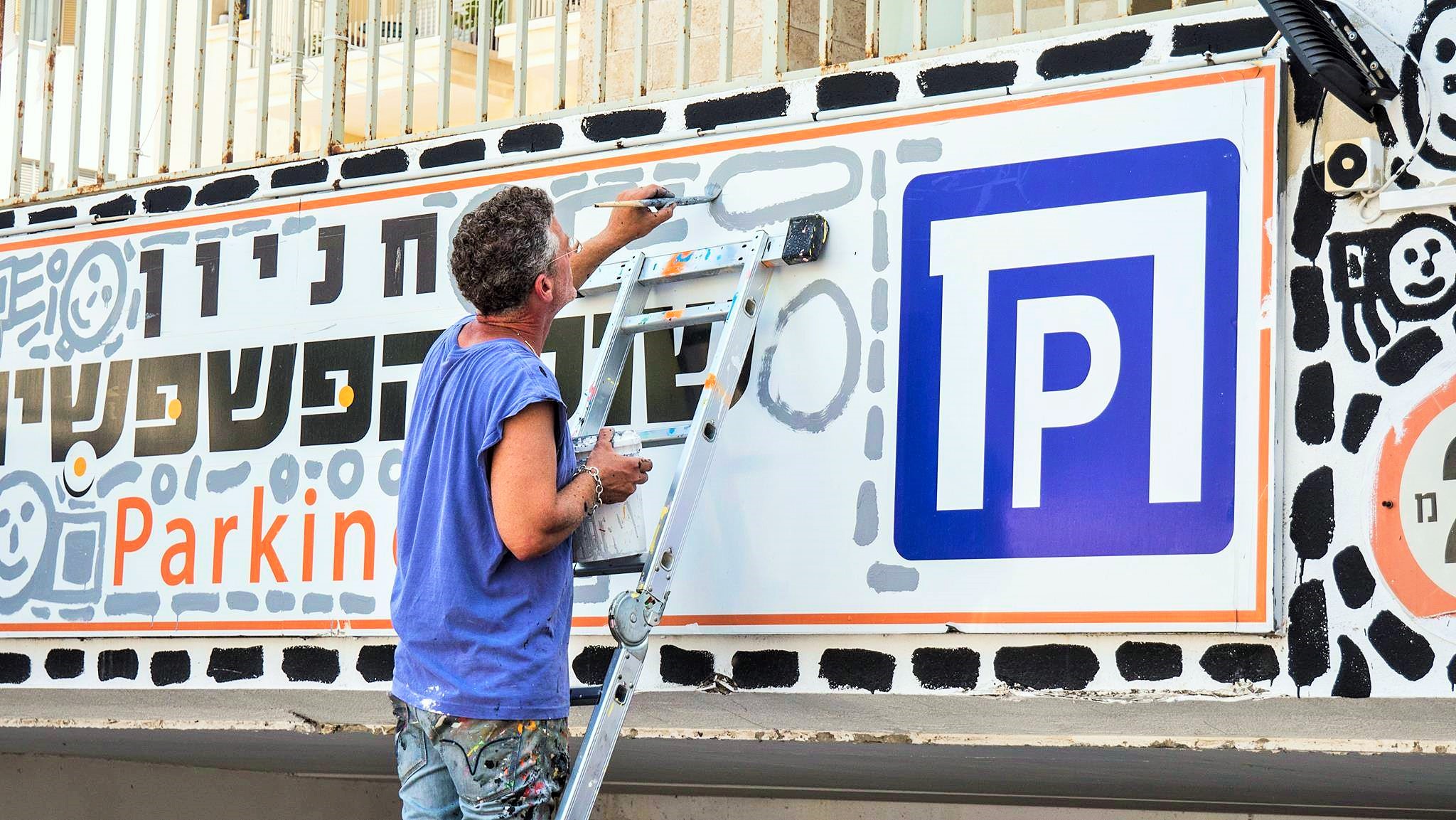
I just had to think about the neighborhood Florentin.
Florentin, right! I think Florentin is one of the major areas in Tel Aviv which has streetart. And of course the Carmel and areas that are kind of next to them. And it is slowly expanding across the city. Tel Aviv is a very young city therefore it is very open. So the city itself is very encouraging a lot of streetart and a lot of artistic activities. That´s very nice. Besides that personally you asked me about my style. I come from a very classic approach to it and I haven´t really spray canned around but I work with the brush. I am a brush guy. I like to feel the material and to feel the wall, to feel the paint and touch the texture of the paint. And I think the brush allows you also to make a better connection with your body when you create. It´s one piece then. The brush and the artist. I am sure some spray can people would say the same but I am more from that classic point of view. I use the brush also because it has a lot of mistakes in it. The dripping and the movement and the thickness of the paint that change it. And this allows me many times to create something that I don´t always know what it will be in the end. It´s a sort of a surprise because a lot of these things happen along the way.

Everybody has to find his or her own instrument. Yours is the brush.
Absolutely! It´s part of the signature of the artist I think.

You said you like to paint on big surfaces and on big backgrounds. So what is bigger than a house, or a big house.
Oh yes. I am always looking for a nice wall. I actually haven´t really done a total building which is something I would like to do. That would be fantastic and it is a project that I am looking for. To paint an entire building. But I have covered a factory which is here in the city. It wasn´t hand painted, it was actually a huge print of a painting of mine. But it was about 1600 m² in size, so it was very big. We had here in the middle of the city an old milk factory and the city didn´t like the way it looked. It´s not actually working and it was an old factory. Before they turned it into sky raisers that they built, they wanted it to be taken care of. It looked so bad. So they invited me to do something and what we did was that we covered actually the entire factory which is an entire block on the street. We did that with a printed painting which was a huge piece. And we did it on this net because there are really strong winds there. I created actually an entire street. On the other side of it there was a building. This high-tech building of mirrors and you actually got the reflection of the image from the milk factory from across. So when you drove through it, it was like you are driving through a painting. That was pretty funky. But I am still looking for that handmade building. That´s something that I haven´t done yet.

How do you get to the pieces, to the locations or to the walls? How do you find them? You cannot just go and paint somewhere, you have to ask people? Or do you?
Well, it really depends. I´ve done some stuff where I didn´t really ask because it looked like a good place. I tried to find places and I´m not looking for vandalism or something like that. I usually find a place where actually people will be cool with it. So far I have been lucky there and a lot of the projects I´ve done, I actually was approached by people who invited me to do it. Big projects for people who know the work and actually just said: “Hey, come on, do it here.” On so most of that kind of projects started. There were even places which are a complex and several people are living in the same building and they all together invited. So it really varies. It´s a lot of fun because of that, because it shows it is a fun community and it´s about let´s share the art. So far I find people who are actually into it. You don´t really need to look to hard to find empty walls. There are plenty of places to work on that people want. So it is a combination of both.


When I was in Tel Aviv I´ve seen so many artworks on the house walls, I had the feeling that it is more accepted there than in other places. And that it would be more okay if you just go and paint somewhere. But I didn´t really know how it would be with the police or the legality. But if a whole community accepts a bit more color on the facades it is more alright if others come and just paint.
In a way yes, that´s right. But Tel Aviv is divided. The city located areas which you can paint are usually run down areas in the south part of the city. These are areas which are not really newly built. There are areas up in the north of the city where I´m sure if people would start painting there the police will come and the neighbors will come and that would be not so positive. So in these other areas you can do a lot. There are a lot of shop owners who want it and the people really want it. They want to have art on their buildings. Because the buildings themselves are pretty run down. So it´s kind of a free paint yard you get as an artist and the same way around. It really depends where in the city you are doing it. If you look into provoke than you can go to some areas in the city and do it and almost for sure you will be arrested and get some kind of fine. It´s positive in certain areas and like always it´s not all over the city. But I think that the audience is very positive from all over. People like streetart. It´s something which in many ways replace the galleries that were in the past. And I know that many live from streetart and they prepare also art that they actually can sell or do commission work. It created a whole new world. And with the Corona it makes it even more extreme. Because now with the Corona the best thing is to be outside and not inside a closed gallery. So all these open galleries became a great way for people to walk around, drink beer and see what´s happening. Maybe in a way that gave a boost to streetart now.

That would be nice. Of course the new buildings, a bank or something which is in the government district or like the areas you mentioned, there it is not allowed and not accepted. But if have a look on all these run down places with dodgy streets and which don´t look very nice, there the people realized that if the artists put on some artworks it´s really an upgrade. It really makes something before ugly and destroyed into something lovely, interesting and creative again.
Totally! It´s even more than that. You can see it in Florentin which is an area with a lot of streetart. The streetart actually brings the young people. It makes bar open, it makes clubs open and pizza joints and all kind of places like that. They have life around it because it becomes a fun place to be. So it actually has a great economic value to the city. It´s way beyond just decorating the walls. It´s creating a whole vibe. A whole new vibe. You see many areas with streetart which became central areas where young people are going out at night. And other places which were not touched and are clean, they became totally empty at night because there is just no life there. I think it is very important to what is happening today. Our urban visual that we see is changing and becoming something alive. And it´s very dynamic also. Every time new pieces are coming up and pieces change. Many things are happening. Streetart is also something which is not permanent which is very nice. It´s very dynamic in that way. Just weather makes it peel and change and stuff like that. So it´s always something interesting to see.
I´ve seen here some information from you about tours. So you are doing streetart tours yourself and you explain the art in the streets to other people as well?
I do that just for fun sometimes. People come to my studio to visit and they ask me to give them tours around my neighborhood which actually has quite a lot of streetart. I´m very local and I know the area and I like walking around. So I give sometimes these tours, but they are not professional tours. They are fun tours for my studio. I show the stuff that I like. That´s the idea.

But I think you give of course a lot of background information about the stuff you like. So the people will get a lot of insights.
Yes, I think so. I´ve done only a few of these and I do it for fun. Usually people who come to the studio are also very interested how people have done it and who they are and stuff like that. Or other streetartists come or students from me from the past. I have these little stories which I can add to the pieces and this enriches the experience a little bit.
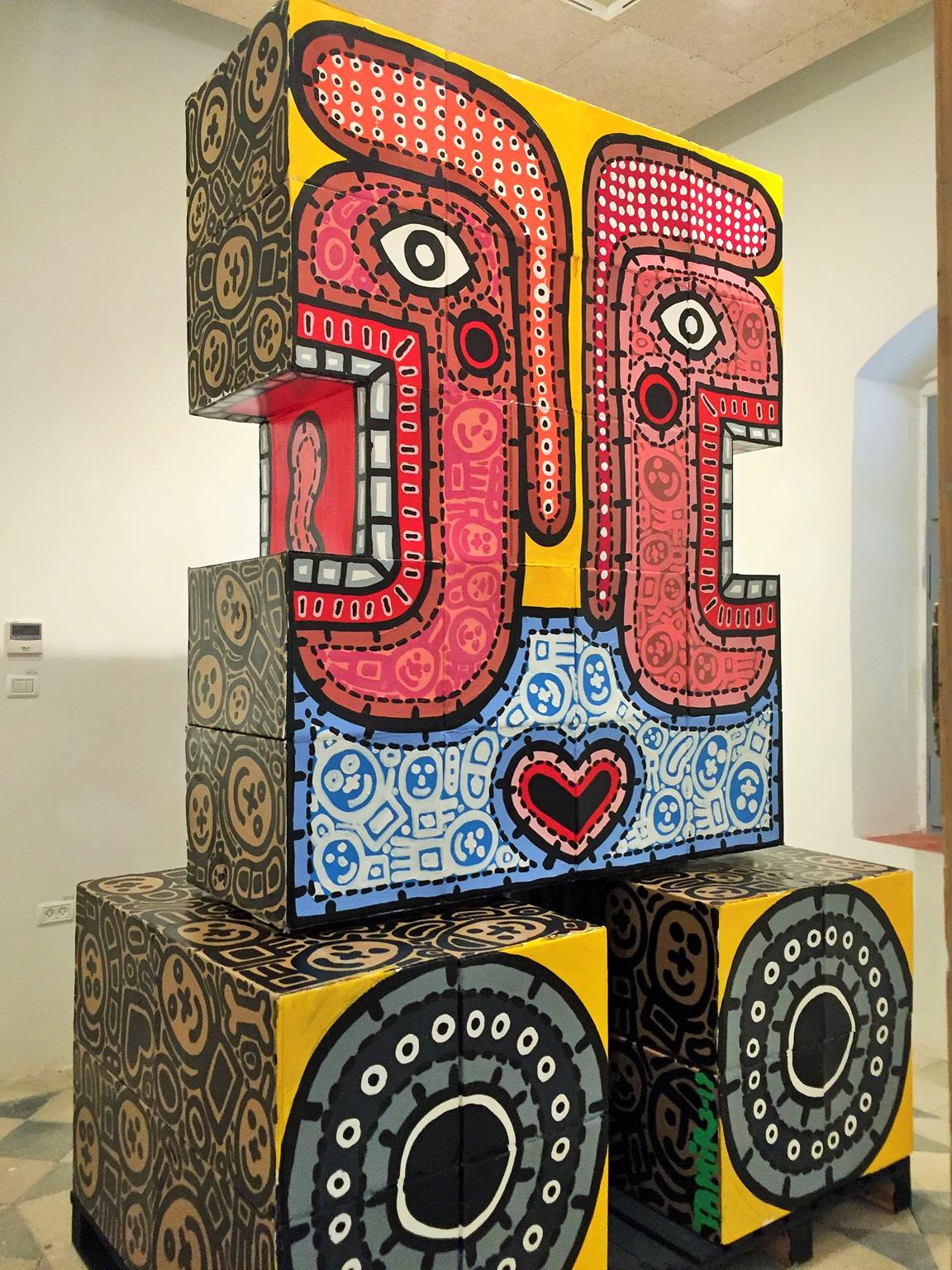
Very very nice Tamir! Thank you for this nice interview, or let´s say these nice two interviews. I hope one day I will visit Tel Aviv again and then you have to show me around as well.
Well thank you! It was a pleasure. And I am waiting for your visit. I would love to take you for a tour here. There is some good beer and some nice arts! And I´m sure you will enjoy it very much. So I´m waiting for your visit.

THE ARTIST ABOUT HIMSELF
Tamir Shefer was born in San Francisco, California in 1963. In 1970 he immigrated with his family to Israel. After completing his army service he attended the Bezalel – Israel Academy of Art in Jerusalem (where he studied as well with the fabulous photographer Dana Arieli) and in 1989 he received from Bezalel the degree, Bachelor of Arts in Industrial Design. From a very young age Tamir was engaged by local newspapers and magazines where his art work – caricatures and illustrations, could be found weekly. From l992 to l997 he operated a very successful art studio, “X-Taza” in California, USA. During this period he served as Art Director, developed and designed a multitude of interactive products for different commercialised platforms. Concomitantly he published illustrations in several National newspapers such as the “Village Voice” in New York, the “San Diego Union Tribune” and the “San Francisco Bay Guardian.” In 1998 he established the “Tamir Shefer Studio for Art and Design” in Yafo, Israel. The studio caters to a variety of clients. It deals with development, design, illustration and interactive printed products for a sundry of platforms. This is in addition to specialised art projects. Among them are: stage design for the theater, games design, book illustrations and Fine Art exhibitions. Tamir does not explain the hidden meaning of his art work. He tries to provoke the spectator by raising questions. He does that by integrating familiar symbols in mixed media. Many of his works are designed like a box where the central figure is confined within the space surrounded by fences.
He believes that society today is overcrowded and such is his art work: dense, colorful and full of symbolism and images. The symbols that often appear in his work are very familiar: dolls, soldiers and flags- symbols that deliver to the viewer’s eye critical messages concerning our society. He uses these images and symbols in a repetitive manner that takes on the aura of meditative rituals. Tamir’s art work has been shown in many solo and group exhibitions. In l996 he had a one man show “Comix by the Bit” in the San Francisco Cartoon Art Museum. In 2004 he had a one man show of his paintings in the “Gallery on the Rock”, in Netanya, Israel. In 2006 he exhibited his paintings in the Sheraton City Tower Hotel in Tel-Aviv, and in 2013 he had a solo exhibition in the Dada Museum in Ein Hod, Israel, to mention only a few. From 2004 till 2007 he had a revolving art exhibition, part of a program of “Bringing Art to the People” sponsored by the Israeli Ministry of Education, Art and Culture. The exhibit was shown periodically in different parts of the country. Tamir’s art has been exhibited in various galleries and museums in Israel. Several of his paintings were commissioned and others have been purchased by prominent art collectors. Since 2008 Tamir has been represented by Art28 Germany exhibiting his art works in many group and solo exhibitions around Germany. In 2002 he joined the Faculty of Design at the Holon Institute of Technology. Tamir divides his time between painting, multi media commercial projects and as Head of the Department of Visual Communication and Design at Holon Institute of Technology (HIT), in Israel. Tamir lives in Jaffa, Israel with his two daughters: Kami and Ella.
INFOTHEK
![]() Website: https://www.tamirshefer.com
Website: https://www.tamirshefer.com
![]() Email: tamir.shefer@gmail.com
Email: tamir.shefer@gmail.com
![]() Facebook Page: https://www.facebook.com/Tamir-Shefer-124226281520
Facebook Page: https://www.facebook.com/Tamir-Shefer-124226281520
![]() Facebook Profile: https://www.facebook.com/tamir.shefer
Facebook Profile: https://www.facebook.com/tamir.shefer
![]() Instagram: https://www.instagram.com/tamirshefer
Instagram: https://www.instagram.com/tamirshefer
![]() Photo Credits: All images contributed by Tamir Shefer
Photo Credits: All images contributed by Tamir Shefer

MORE ARTICLES ABOUT ISRAEL
>>> Painter Tamir Shefer <<<
>>> Photographer Dana Arieli <<<
>>> Streetart – Tel Aviv <<<
>>> Streetart – Florentin <<<
>>> Streetart – Jerusalem <<<
>>> Interview – Andrew from Capzoola <<<
>>> Interview – Sprayer EVYA <<<











